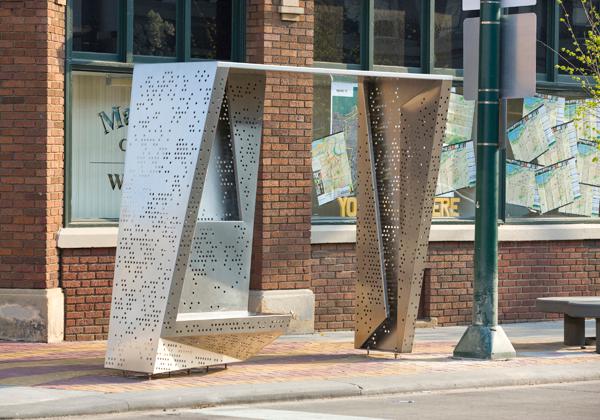
#LANDSCAPING AND URBAN PLANNING PROJECTS
Gordon Square Bus Shelters
Architects’ contributions to the public realm are more than just the façades of buildings.
They also include street furniture and other elements of urban design, especially in cities where design is valued for making contributions to a sense of place. Robert Maschke Architects’ designs of two bus shelters are a striking addition to the Detroit Avenue Streetscape in Cleveland, Ohio. The architect answered some questions about this urban design project.
What were the circumstances of receiving the commission for this project?
Robert Maschke Architects was commissioned by the city of Cleveland based on the firm’s design profile and commitment to the neighborhood where the shelters are sited. The project consists of two bus shelters designed for the Gordon Square Arts District within Cleveland’s Detroit Shoreway neighborhood. The brief called for the creation of functional and iconic elements to be incorporated as a part of an ensemble of new pieces of public art slated for the highly anticipated Detroit Avenue Streetscape project.
Can you describe your design process for the building?
Conceptually, the design is conceived as a single stainless steel surface which wraps and folds to create the shelter. The singular material enhances the sculptural quality of the modestly scaled shelters. Folds in the surface are determined by the accommodation of functional, contextual, and structural variables, which merge to generate the shelter’s shape. A pattern of perforations moves across the surface of the shelter which responds to localized conditions of sun, wind and view. In the evening the shelters are internally illuminated, projecting a subtle dithered pattern on the surrounding buildings and surfaces transforming the existing context and incorporating it as a part of this new vibrant installation.
How does the completed building compare to the project as designed? Were there any dramatic changes between the two and/or lessons learned during construction?
The bus shelter was conceived and designed using a combination of Autocad and 3d modeling. Digital models were used to create renderings and physical models which informed the design of the bus shelter. The models and drawings were used by the fabricator to create a template of the exact design. The final components of the shelter were cut from the templates and welded together. The final product was installed as designed without any changes to original design.
How does the building compare to other projects in your office, be it the same or other building types?
This project continues a series of investigations at multiple scales, over the last several years, of single surface organizational strategies and the capacity to incorporate multiple functions into the single surface.
How does the building relate to contemporary architectural trends, be it sustainability, technology, etc.?
This project utilizes digital fabrication techniques. Seamlessly translating from the design software to the fabricator.
Are there any new/upcoming projects in your office that this building’s design and construction has influenced?
Yes, Robert Maschke Architects Inc. is currently working on a private residence that will deploy similar technologies at a larger scale.



